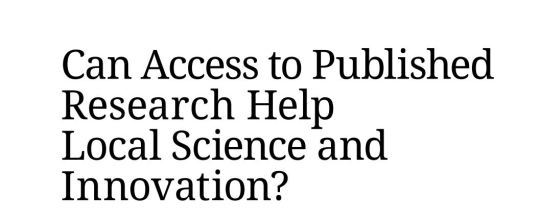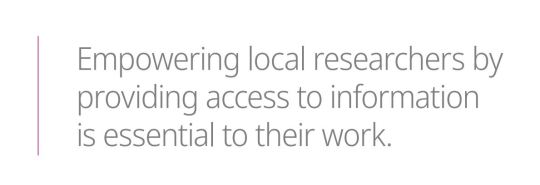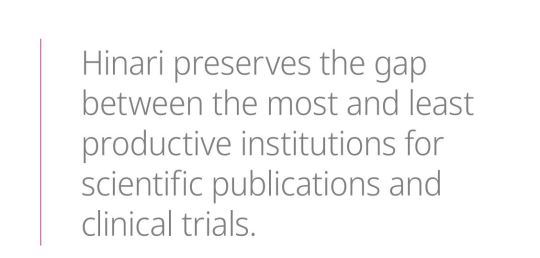#Technology and Innovation Support Centers (TISCs)
Explore tagged Tumblr posts
Text
Can Access to Published Research Help Local Science and Innovation?

Low-cost access to information can drive research and clinical trials in developing economies and contribute to SDGs. But different regions are affected in different ways. So how can low-performing institutions catch up? So far, the public debate on access to medicine, neglected diseases, and patent-protected technology has underplayed the potential of access to information for economic development. Similarly, earlier research has revealed a startling gap between lower- and higher-income countries in terms of access to knowledge, with over half of medical institutions having had no subscriptions to academic literature in lower-income countries.

Several UN agencies and major academic publishers launched the Research For Life (R4L) initiative to fill this gap. The World Health Organization (WHO) runs Health InterNetwork Access to Research Initiative (Hinari), one of fiveprograms under the R4L umbrella. It provides free or low-cost access to academic literature to at least 270,000 researchers in over 100 developing economies. This is for this WHO-led program alone. The entire initiative includes more than 21,000 peer-reviewed journals, 69,000 e-books and 115 data and other sources. Focusing on Hinari, a new WIPO research paper carried out empirical analysis of millions of data points to understand the strengths and weaknesses of the program. It is the first study to link access to scientific publications in developing countries to welfare along the science-to innovation pipeline. The report shows a local increase in health science publications of up to 75% after joining Hinari. Likewise, involvement in international clinical trials grew by over 20%, suggesting that research and innovation in local institutions improved. Screening over 36 million scientific papers in PubMed, a repository of health science, the study found more than 167,000 papers coauthored by local researchers in developing economies, which cited clinical trials conducted worldwide over 30 years.

However, this uptick in science publishing and clinical trials only partially translated into global patents and inventions. The study attributes this to developing countries often lacking infrastructure and funding to transfer new findings into patented technologies. This gap reveals the remaining challenges in developing innovation and IP systems. Moreover, the study also finds that local context matters. Institutions in specific regions and those that already had a high research performance benefited most from the Hinari program. This also means that it is harder for others to catch up, despite better access to information.
Access to global knowledge counts on the ground Empowering local researchers by providing access to information is essential to their work. Researchers tend to target diseases that affect the local population and may be overlooked by researchers abroad. Enabling such access may help innovation in neglected diseases, mainly by connecting local teams to the global knowledge base. Aside from increased scientific activity, R4L also reports direct effects from Hinari regarding medical practice and patient care. The initiative quotes Dr. Nguyen Duc Chinh from Viet Duc Hospital, Hanoi, Viet Nam: “Good research, in short, leads to better patient care.” The doctor relied heavily on Hinari for his PhD on intestinal TB and surgical treatment. TB is prevalent in Viet Nam, but there is a relative lack of information on intestinal TB. “With the information and knowledge we obtain,” he says, “we feel more confident in practicing and implementing respected medical expertise from around the world.” Dr. Sami Hyacinthe Kambire at Kamboinsé Research Station, Ouagadougou, Burkina Faso, also found his research progressing faster and wrote grantwinning funding proposals thanks to Hinari. Before his institution adopted R4L, Dr. Kambire often devoted considerable time to research already

performed elsewhere. The initiative helped reduce these duplicative research efforts in global health sciences and increase the quality of local teaching and education.
Access to information affects institutions differently Despite the impacts, the study also found that the program effects differed for different parts of the world. Research institutions in the Carribean, Central Asia, Europe and Latin America benefited the most in generating new scientific knowledge. On average, their academic paper output increased by 80–100%. Regarding clinical trials, program participation is most impactful for East Asia, the Pacific, the Middle East and North Africa. Trial activity rose by up to 35% at institutions in these regions. That does not mean other regions did not gain from the program, but the impact has been less pronounced.

However, there are also institutional differences. Notably, the study authors wanted to avoid comparing apples to oranges, because high- and low-performing research institutions differ. The high performers might be more likely to adopt the Hinari program in the first place. Seeing more publications might also be an outcome of the institutionsʼ selection into the program rather than an outcome of the program and better access to knowledge on the ground. To reveal the causal effects rather than mere correlations, the study compares different fields. This means health sciences supported by the program are matched against other research fields not supported by Hinari but conducted at the same institution.
How to make the most of access to information Having ruled out the factors described above, the report suggests that program management could improve in two ways. First, it shows that already productive institutions benefit more from Hinari. For example, research institutions that have previously published academic papers see an average 60–70% increase in their publications after joining. This increase is only around 40% for institutions that rarely published scientific works previously. This suggests that Hinari preserves the gap between the most and least productive institutions for scientific publications and clinical trials. Under these conditions, the least productive institutions are, all else being equal, less likely to catch up. Still, the study ultimately supports the view that the Hinari program and the R4L initiative contribute to achieving the SDGs. They help boost research and innovation capacity in developing economies and improve health services (SDG 3) and education quality (SDG 4) at local institutions. They also aim to build industry, innovation and infrastructure, thus encouraging decent economic growth (SDGs 8 and 9).
The R4L initiative is also an excellent example of how private–public initiatives can make a difference. It joins private sector stakeholders from the global publishing industry and research institutions in the UN member states in a win–win situation. For research institutions, the initiative provides a practical solution. Their libraries and labs often need to be better resourced, and R4L improves access to information for students and researchers. It is also a smart way for industry stakeholders to show their corporate social responsibility and enhance their social impact in developing economies. It could also help grow local demand and the customer base in the long term. Moreover, easing access to published research through initiatives like Hinari and WIPOʼs Access to Research for Development and Innovation (ARDI) program can significantly affect research output and contribute to desired social and economic outcomes laid out in the SDGs. UN agencies like the WHO and WIPO have been vital matchmakers. However, addressing existing gaps through schemes such as WIPOʼs Technology and Innovation Support Centers (TISCs) may help build local infrastructure and contribute to a vibrant IP and innovation system. In conclusion, the reportʼs findings on success and remaining challenges may inform stakeholdersʼ decisions to renew or change their commitment to R4L beyond 2025.

#patent-protected technology#Published Research#Local Science and Innovation#research and clinical trials#patented technologies#world i.p. day#26 april#R4L initiative#sdg3#sdg4#sdg8#sdg9#Technology and Innovation Support Centers (TISCs)#Access to Research for Development and Innovation (ARDI) program#ip and the sdgs
0 notes
Text
India’s Second Technology and Innovation Support Center (TISC) Established at Anna University, Chennai
Rohit Sharma 9818863732 Chennai :- The Department of Industrial Policy and Promotion (DIPP), Ministry of Commerce & Industry, Government of India, has signed an Institutional agreement with Anna University to establish India’s second Technology and Innovation Support Center (TISC) at the Centre for Intellectual Property Rights (CIPR), Anna University, Chennai, under the World Intellectual…
View On WordPress
0 notes
Text
DIPP to set up India’s first TISC in Punjab
DIPP to set up India’s first TISC in Punjab
DIPP to set up India’s first TISC in Punjab The Department of Industrial Policy and Promotion (DIPP), Ministry of Commerce & Industry, Government of India, signed an Institutional agreement with the Punjab State Council of Science and Technology in New Delhi today to establish India’s first Technology and Innovation Support Center (TISC) at P……
View On WordPress
0 notes
Text
Current Affairs Questions of 15th July 2017
(Q) World Plastic Surgery Day is being observed on which date ? (A) 15th July (Q) India overtook which country to have 241 million active users on Facebook ? (A) USA (Q) Who has been named as the brand ambassador of the Indian Indoor Cricket Team ? (A) Sandeep patil (Q) Name the supercluster of galaxies discovered by Indian astronomers ? (A) Saraswati (Q) Who has been appointed as Chief Digital Officer of Tata Sons ? (A) Aarthi Subramanjan (Q) As per a report published by _______ , Patanjali has been rated among the top 10 most influential brands in India. (A) Ipsos (Q) India‘s first Technology and Innovation Support Center (TISC) will be setup in which state ? (A) Punjab (Q) India on July 14, 2017 contributed $___ million to India-UN Development Partnership Fund. (A) 1 (Q) Who is the author of the book, ‘President‘s Lady‘ ? (A) Sangeeta Ghosh (Q) The sale of old jewellery by an individual to a jeweller will not attract provisions of section ___ of the CGST (Central GST) Act. (A) 9(4) (Q) As per a report published by ________ India ranks 2nd with highest number of adults planning to migrate (A) International Organization for Migration (Q) _______ has become the first woman CEO of Iran Air. (A) Farzaneh Sharafbafi (Q) The 2017 Sustainable Development Goal (SDG) Index and Dashboard report released. As per the report India ranks ______. (A) 116TH (Q) State Bank of India reduced NEFT, RTGS charges by _____%. (A) 75 (Q) As per a report published by _______ on July 14, 2017, 73% of Indians trusted the Modi government. (A) Organisation for Economic Co-operation and Development (OECD) More Current Affairs Questions on 15th July 2017 : http://ift.tt/2t0TUTf
From Blogger http://ift.tt/2ukgeeJ via http://ift.tt/2aY4od2
0 notes
Text
Bringing Renewable Energy to Local Farmers.

Eco-innovative farming solutions are vital to ensuring the global reduction of greenhouse gas (GHG) emissions related to agriculture. Biodôme du Maroc, a small, fast-growing Moroccan company, provides local farmers with a technology that gives them access to renewable energy for on-farm use. Founded in 2013 by Dr. Fatima Zahra Beraich, Biodôme du Maroc is the first Moroccan company to specialize in the recovery of organic waste through natural treatment and environmentally friendly processes. This is to enable farmers in rural areas to produce biogas and fertilizer.

For the environment, biogas helps to reduce greenhouse gas emissions from abandoned organic waste and minimizes the risk of polluting waterways. This “clean” method of energy production also reduces reliance on wood as a fuel source. Biodôme du Maroc offers a range of small-scale agricultural anaerobic digesters. These digesters use a simple and innovative system to produce biogas and recover organic matter. Inside underground concrete enclosures, farmers can deposit different kinds of organic waste, such as household, plant and animal waste, which is fermented in a biological accelerator. In this process, gas is produced through methanization or anaerobic bio-digestion, where bacteria naturally break down organic matter within weeks.

By providing a technology that produces gas from organic waste, Biodôme du Maroc gives local farmers access to renewable energy for agricultural production.
Dr. Beraich currently holds six patents covering innovations that improve the efficiency and performance of Biodômeʼs bio-digesters. “The process of securing a patent means that our technology is evaluated by experts and allows us to understand just how different our inventions are from other competing technologies. This allows us to protect the inventive characteristics of our outputs,” explains Dr. Beraich. “With these patents in hand, we hope to be able to license our more recent patented innovations.” The support of the Moroccan Association for Research and Development (R&D Maroc) – part of the network of Technology and Innovation Support Centers (TISCs) in Morocco – has played a critical role in the success of Biodôme du Maroc. “I learned about the TISC network at an outreach event at the University organized by the Moroccan Industrial and Commercial Property Office,” Dr. Beraich explains. R&D Maroc helped Dr. Beraich secure seed funding and also ensured she had the help she needed to draft her patent applications, and license and access the technology she required to create and commercialize her bio-digesters. Biodôme is currently marketing its patent-protected bio-digesters in Morocco and across Africa.

#Eco-innovative farming solutions#worldipday#26 april#sdgs 12#sdg13#sdg11#sdg6#sdg7#ip and the sdgs#ip at work#sustainable agricultural#competing technologies#invention#patented technologies#patented innovation#Technology & Innovation#Innovation#r&d#Moroccan Industrial and Commercial Property Office#morrocco#bio-digesters#patent application#patent-protected
0 notes